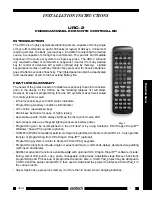
Other 5 outputs of ocBridge are service zones and correspond to the service
inputs of the alarm system central unit.
The table provides the description for main and service zones’ contacts:
The receiver is connected to the central unit as explained by the scheme:
The alarm zone reacts to bistable detectors (e.g. DoorProtect and
LeaksProtect) with opening/closing, depending on setting “Initial state”
(NC/NO). The zone is in alarm mode until the bistable detectors state
returns to its initial state. The zone reacts to impulse sensors (e.g.
MotionProtect, GlassProtect) with opening/closing depending on setting
“Initial state” (NC/NO) with the impulse, its duration can be adjusted by
the setting “Impulse time” (PICTURE 19). By default, the “Impulse time”
is 1 second, 254 seconds maximum. If alarm is raised, the zone’s red light
“3” is on (PICTURE 1).
Automation zone can be set as NC or NO (PICTURE 20). When the
“Impulse” way to react is chosen, the zones reacts to all activations with
opening/closing, depending on “Initial state” setting for the time set in the
setting “Impulse time” – 1 second by default and 254 seconds maximum.
When the “Trigger” reaction mode is selected, the zone output changes
its initial state to the opposite one with each new activation signal. The
light indicates the automation zone’s current state – with the activation
signal, a red light turns on or turns off if the normal state is restored.
With the trigger reaction mode, “Impulse time” parameter is unavailable.
Arm/disarm zone is used only for keyfobs and keyboards connection
(PICTURE 21).
6.4. Zones are divided into 3 types: alarm zones, automation zones and
arm/disarm zones (PICTURE 18). Zone type is selected when the zone is
created, consult paragraph 4.2.
The alarm zone can be set (PICTURE 19) as NC (normally closed contacts)
and as NO (normally opened contacts).
PICTURE 18. Selecting zone type
PICTURE 19. Alarm zone settings
PICTURE 17. ocBridge receiver’s service outputs and power supply
11
12
13
14
15
16
17
18
Output №
MARKING
DESCRIPTION
1
1
1st zone output
2
2
2nd zone output
3
3
3rd zone output
4
4
4th zone output
5
5
5th zone output
6
6
6th zone output
7
7
7th zone output
8
8
8th zone output
9 (Input)
IN
wire input for connecting to the central unit
output (for alarm system arming/disarming)
10
ground for connection to the central unit
11
+
power supply plus
12
–
power supply minus
13
T
“Tamper” service output
14
S
“Connection failure” service output
15
B
“Battery” service output
16
J
“Jamming” service output
17
T1
“Tamper” service output
18
ground for connection to the central unit
PICTURE 20. Automation zone settings
PICTURE 21. Arm/disarm zone settings
PICTURE 16. Main outputs and input “IN” of the receiver
1
2
3
4
5
6
7
8
9
10
opens (by default, the output can be also set for closing) the wire output
corresponding to the sensor.
The alarm system’s central unit reads the output opening as the sensor’s
zone opening and sends an alarm signal. If it is mentioned that the central
unit zone must have high resistance between the receiver’s output and
the central unit zone, the resistor with nominal required by the central
unit must be placed with serial connection. Observe the polarity while
connecting the wires!
6.3. The outputs with numbers 1–8 (PICTURE 16) correspond to 8 main
nominal alarm zones.
























